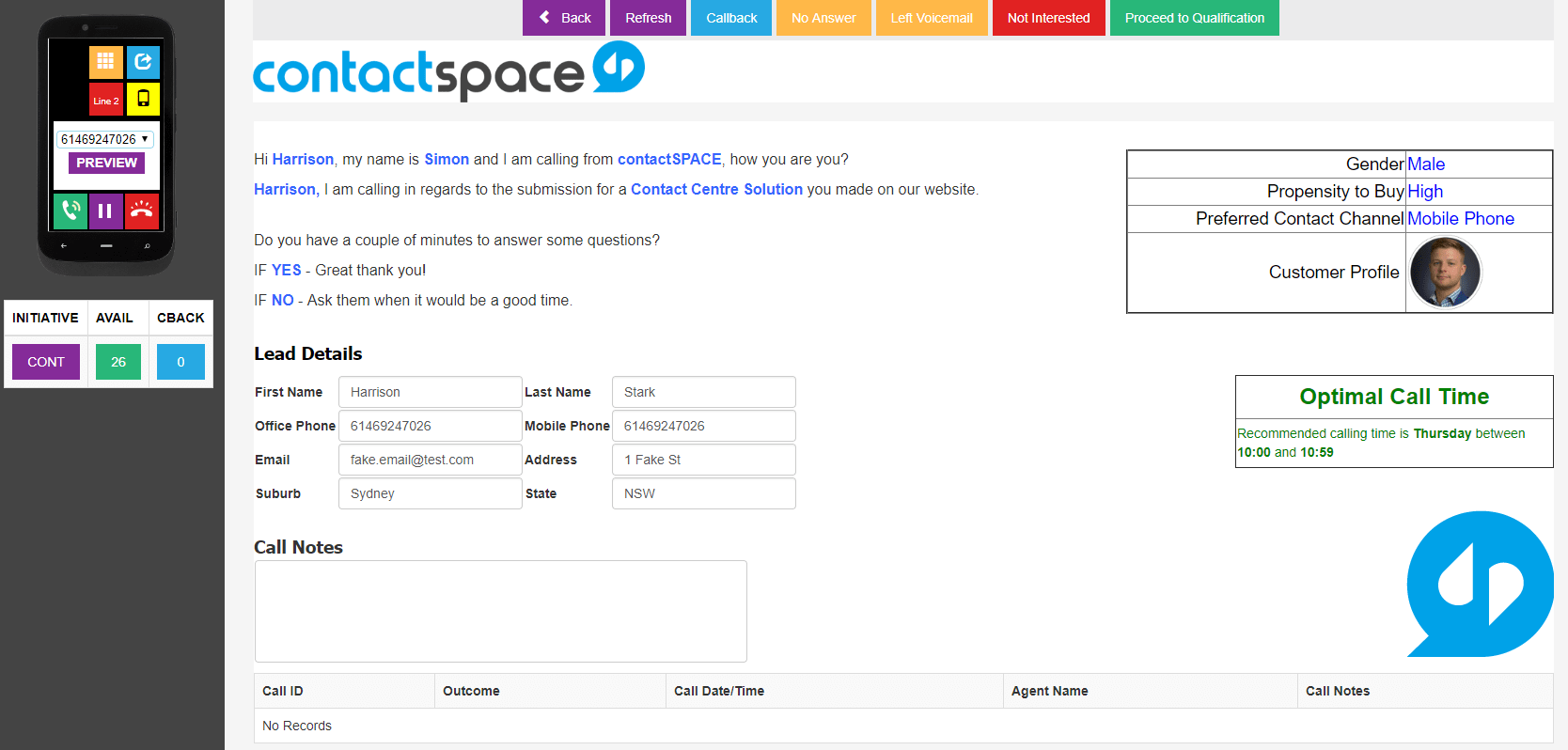Looking for the latest and greatest contact centre trends you can use to improve interaction quality and increase overall productivity?
In this guide, we’ll discuss 17 of the most useful contact centre best practices as of 2021.
We’ll look at metrics/benchmarks you can track, strategies for training, and other methods of improving the effectiveness of the conversations you’re having – both inbound and outbound.
1. Employ voice analytics

Something you’ll find in the contactSPACE software suite is voice analytics.
Voice analytics software processes call recordings and looks at the words spoken, as well as how they’re spoken – for example: the tone, pace, pitch, and amplitude used.
Essentially, it’s technology which allows you to identify patterns and trends in the conversations your agents are making, without having to manually listen and make notes on thousands of calls.
This software can be incredibly useful for:
- Identifying which products customers are having the most trouble with (identified by product names mentioned, and the tone used – is the customer angry?). This can provide valuable insights for your product team.
- Understanding why an agent/team’s performance is dropping – are they speaking in an empathic tone, and giving the customer the chance to speak? Or could their attitude be improved?
- Discovering what words your agents can say – and how they can say them – in order to maximise the number of sales/successful outcomes they’re making. Which phrases are more likely to encourage the prospect to say “yes please”, and which result in them saying “maybe later”?
2. Drop talk-time/calls-per-hour metrics
In recent years, call centre managers have found that an over-reliance on these sorts of KPIs can be dangerous. You don’t want your team rushing to start calls without previewing them properly, nor do you want them hurry to get a customer off the line.
Instead, focus on outcome over process. Some more useful metrics you can measure:
- Number of resolutions/sales per agent.
- Profit/cost per call.
- First contact resolution.
3. Chuck out (or reconsider) your scripts

People are fed up of being called and fed a monologue that’s clearly been extensively scripted – and would you blame them?
You have a dilemma here. On the one hand, you need to keep your agents on-message – especially those who are fairly new to your organisation. At the same time, you want to enable better conversations, rather than just soapboxing to your lead.
Here at contactSPACE, we came up with an clever solution to this problem. ?
Our agent interface has what we’ve dubbed CallGuides®: an intuitive way of integrating the conversation flow and agent workflow, all in one place. You can define exactly what fields you’d like to display and enable the user to edit – changes are automatically sent to your CRM.

This not only enables agents to have more effective conversations (using accessible, personalised data), it also cuts down on wrap time and exponentially increases task efficiency.
Around these fields you can populate the rest of the preview screen with a script or a rough outline for the agent to follow when talking – the choice is yours. Plus, it’s super easy to make whatever layout you want using our clever drag-and-drop editor.
4. Provide training through real-world guidance
Without Googling it, think about this – what are logarithms, and how do they work?
Having trouble?
The truth is, it’s easy to forget stuff you learnt in a classroom environment, especially when you’re overwhelmed with a heap of information you’re supposed to remember in a short period of time. Why, therefore, would you train agents this way?
Well, sitting your team down and teaching them stuff can be useful – otherwise you’ll find yourself bombarded with questions from day one of an employee’s tenure. It’s essential for agents to understand the ins-and-outs of your product, especially in customer service.
However, there’s a simpler, more effective way of improving performance. When an agent asks for help, or you notice that they need support, go and provide some constructive criticism/actionable advice (while also praising what they’re doing well).
Not only is this a great method of providing super-targeted feedback, it’s easier for agents to remember information they’ve received in this way. When they encounter a similar situation in the future, they should (hopefully) think about what you said the last time it happened, and take your advice into account.
5. Get involved

Following on from #4, consider if you’re involved enough in your team’s activities.
As a manager, it’s your job to define your agents’ goals and outline how these objectives will be achieved. But it’s not all going to be smooth sailing – what if your team runs into an unexpected difficulty – an objection that wasn’t considered, for example?
In these situations, you’ve got to be there to help. There’s no point sitting in the chateau doing paperwork 24/7 – sometimes, you’re needed on the front line.
Make it clear to your team that you (or their direct supervisor) are there to help them. This has the added benefit of encouraging your agents to ask for assistance if they’re ever in trouble, which gives you the chance to provide highly-targeted feedback.
6. Provide omnichannel accessibility
Millennials and Generation Z are increasingly abandoning voice communication in favour of social media, SMS, live chat, and even plain old email. According to Ofcom, only 15% of 16-24 years olds consider phone calls to be the most important form of communication – 36% prefer to chat over instant messaging services.
Therefore, to maximise engagement when targeting younger market segments, you’ve got to have omnichannel communication capabilities.
Reducing your reliance on phone calls can also save costs. For customer service operations, it’s often more efficient to have an agent responding to inquiries using live chat, as it empowers them to manage multiple conversations at the same time.
However, this will depend on the types of problems you’re dealing with. Explaining how to navigate through a series of web pages or your app can prove very difficult over text!
7. Prevent the call from happening in the first place
Organisations have realised that often the most efficient form of providing customer service is to reduce the chances that the customer will have to get in contact, except when dealing with the most complex of issues.
Rather than waiting for the calls/support tickets to roll in, give the customer a means of solving the problem themselves. People often like to consult Google, YouTube or even Alexa to try and fix their issue sooner.
For example, Salesforce have a website called Trailhead, on which they provide advice to developers making solutions on their app. Plus, they upload helpful tutorials on YouTube to prevent people having the contact them to solve simple issues.
8. Create an advice library
Following on from the above tip, if you tend to deal with the same problems on a regular basis, it might be worth having your customer success team create a library of solutions to these problems.
This resource could be made up of stuff like video demonstrations, diagrams, and step-by-step troubleshooting guides. Then, you can either refer customers to these resources when they call in, or use them to help guide less experienced agents through difficult calls. This helps to reduce the amount of time your team has to keep the customer on hold while they come up with a solution.
9. Be flexible with your staff

Ultimately, as a manager, you want access to the best possible talent, and you want to minimise employee turnover. You also want employees to actually value their jobs, and be enthusiastic about turning up to work.
Here are some ways of improving your human resources processes in line with industry best practice:
- Don’t be afraid of hiring remote agents. Being flexible here can massively increase the available talent pool – especially if your contact centre isn’t located in a major city.
- Allow employees flexibility with their shifts and working hours, including the option to work from home, where possible.
- Monitor break time, but don’t place too much emphasis on it – instead, focus on the actual outcomes your agents are achieving. It could be that the breaks an agent is taking are enabling them to find the extra level of clarity needed to make an awesome call.
10. Make the office somewhere you actually want to be
Another thing you can do to reduce turnover and absenteeism is sprucing up your contact centre. Best practice these days is to make your office more than just a workplace – keeping the employees’ needs (other than just completing work) in mind.
You don’t have to go full Hilton (management might not approve!) – there are some more cost-effective measures you can take:
- Upgrading chairs, desks, monitors – perform a full ergonomics review. If your furniture is wearing out, employees will be stiff and achy by 3-4PM, which could distract them from their work.
- Add some fun activities – table soccer and air hockey are great places to start!
- Enable employees to exercise on the job – if you’ve got a shower already (and a spare room), you could get a few treadmills or some weights.
- Upgrade your bathrooms – nothing’s worse than a terrible toilet.
11. Free your agents

The pitfalls of micromanagement are well-documented at this point. However, it’s still worth keeping in mind that best practice is to make an active effort to give your agents a certain level of freedom to make their own decisions.
For example, if one of your team-members is managing a particularly valuable prospect, don’t feel the need to tell them exactly what to do. Remember why you hired them – rest easy in the knowledge that they have the experience and expertise necessary to achieve your desired outcome.
Obviously, there’s a certain balance to achieve here.
Depending on your leadership style, you still want it to be clear that you’re in charge. You want to be the one that agents look to for guidance, and you don’t want your team to feel like they can do whatever they want. If there is some sort of incentive associated with making sales/resolutions though, you shouldn’t have to worry about agents going off on a tangent.
12. Be smart about managing rostering
Rather than just guesstimating how many staff you need, you should have some sort of system. This will enable you to minimise costs without leaving customers hanging.
How you approach this problem will depend on the type of contact centre you’re managing. Different operations will have different scheduling needs.
Your starting point should probably be your arrival rate – how many calls you get per day, segmented by day of the week, or times of the year. Using previous readings, and accounting for growth in the number of calls you’re making/receiving, you can then begin to develop an idea of what your roster will look like.
Another thing to take into account is your abandonment rate, if you’re dialling predictively. If it’s higher/lower than expected (the maximum monthly figure set by Ofcom is 3%) then you might like to raise or lower the number of staff you’re rostering.
Alternatively, you can use rostering software to make the entire process much, much easier.
13. Develop a customer-centric mindset

It’s very easy to develop tunnel-vision and never look beyond the immediate contact centre environment and what your agents are doing. At times, it’s important to take a step back and put yourself in your customer’s shoes
If you’re in relationship management or inside sales, brainstorm answers to the following question:
What can we deliver than no-one else can?
Then, formulate strategies to best-communicate this message to potential customers. Analyse common reasons for hesitation, and come up with methods of dealing with these objections.
In customer service, you’ve also got to know exactly what information your client needs and how you can best deliver this information to them.
Consider mystery shopping your call centre – it’s good to get an outsider’s perspective. You can even place ads on local Facebook groups to find people instead of hiring an expensive mystery shopping firm if you’re on a tight budget. University/college students are a great place to start – most have plenty of free time, and should be able to provide some decent insights without costing too much.
- Get your group together and briefly introduce your product. Spend a couple hours doing this – if you’re not selling a basic consumer good, it might take a while for your guinea pigs to fully understand your product.
- Come up with a common problem, and have each person ring your call centre to try and fix their issue (don’t tell the agents, obviously). Ideally, you want to have the product in front of each person, as if they actually own/use it. If you like, you could offer a small incentive to those who are able to fix their problem – this ensures that they actually care about finding a resolution (as if they’d spent money on the product).
- Interview each test subject individually and figure out where you could improve. Also have a good listen to the call recordings to contextualise each person’s feedback. Where could you or your agents improve?
14. Embrace the cloud
More and more businesses are moving to cloud-based contact centre solutions (like ourselves ?) due to the flexibility, scalability, and ease-of-use on offer.
Some other benefits of the cloud vs traditional contact centre solutions:
- Easy to deploy – get up and running in hours/days rather than weeks/months. This is super-useful if you ever need to upgrade office, as our friends over at ASTIA found out!
- Serve customers in multiple regions with lower latency. Cloud-based solutions aren’t limited to just one or two data centres.
- Enterprise-grade data security – regular pen tests, all managed by your provider.
- No red tape hassle (like ensuring PCI compliance) – if your solution is any good, your provider will be handling this for you.
- Super-easy integrations with a whole host of CRMs, payment gateways, and other apps (plus custom API integrations).
15. Consider contact centre games

Fortunately, we’re no longer in the era of the industrial revolution! These days, the office can be a fun environment, where teams work together on achieving awesome outcomes.
One way to make the workplace a little more interesting (and help agents feel more comfortable working together) is to come up with a call centre game you can play as a team.
Obviously, not every game is appropriate for every contact centre. However, with some ingenuity, it’s not hard to come up with something that agents will engage with. You can always change or stop doing the activity if it’s not quite working as you’d like it to.
16. Automate menial tasks

As a contact centre manager, you’ve got a lot on your plate. Not only do you have create and monitor initiatives, you’ve also got to look after rostering, managing your software solution, payroll, performance management, keeping up with best practice (like you’re doing now!) and the list goes on.
Best practice is now to automate (or at least, have an application to manage) the majority of the menial stuff you (and your agents) would really rather not be doing. For example:
- Using rostering software rather than Excel to manage employee shifts.
- Nurture leads through CRM workflows – triggered by previous contact results (which agents can input during the call/when wrapping the call).
- Get an automated dialler rather than relying on your hardphone/softphone setup.
- Track and report on metrics from your contact centre backend, rather than going through the hassle of having to use two separate applications. Have the system automatically produce, export, and send you the reports you need on a weekly/monthly basis rather than having to go and make them manually.
- Schedule call-backs with date-based reminders (your CRM is a fantastic way of managing this).
- Ensure your IVR is equipped to handle basic stuff (like bill payments) without disrupting the customer experience.
- Or move beyond IVR, using artificial intelligence to route the customer’s inquiry to the right department. Going down this route removes those annoying “press one for billing” prompts as well, making your customer’s life easier.
We know we keep harping on about it, but the best way of simplifying your workflow is through our CallGuides® module!
Having your CRM connectivity, customer data, and guidelines to help shape the conversation all in one place goes a long way in maximising workflow efficiency, while also improving the actual quality of the conversations you’re having.
17. Keep up to date!
If there’s one thing that’s constant in the modern contact centre industry it’s this: things are always changing.
You’ve got to keep yourself up-to-date with the latest industry trends if you want to avoid your contact centre lagging behind. But homework is boring, and besides – you’ve already got your own industry news to keep up on!
What if we told you… there are a number of ways of keeping up to date with contact centre industry trends and developments, without even lifting a finger!
- Subscribe to our blog using the box below – we’ll email you 1-2 times a month with the latest best practices, news, and contact centre advice.
- Follow us on LinkedIn or Twitter.
- Like us on Facebook.
Applying best practices
Keeping up with contact centre best practice is crucially important. But remember: what works for others may not work for you.
For example, if you mostly serve senior citizens, abandoning phone conversations in favour of live chat probably isn’t the best idea.
You’ve got to be able to take what’s happening in the industry and apply it to your specific organisation. Every contact centre is different, and therefore every contact centre’s specific best practices (to achieve the best possible outcomes) are also different.
Never just apply best practices for the sake of it – consider how exactly each change is going to help you achieve your goals.
